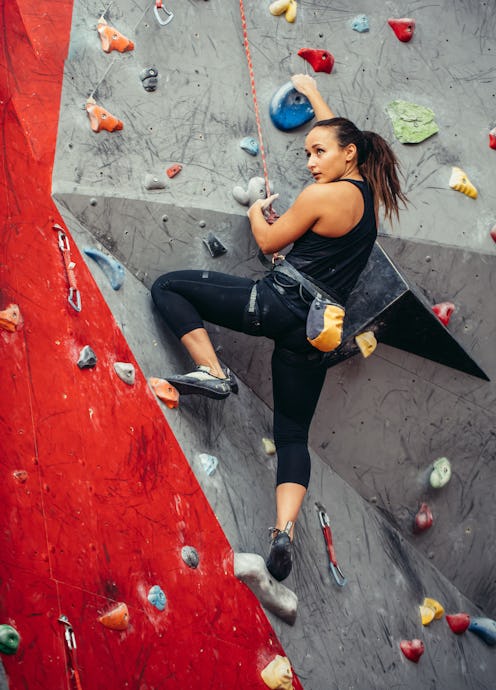Fitness
All The Muscles You Work When Rock Climbing
It's actually a well-rounded workout.

Shutterstock
Indoor rock climbing is a fun challenge and makes for a well-rounded workout, says trainer Dave Mace. It requires some flexibility and coordination, and calls on a range of muscles as you reach, pull, and scramble your way up the wall. Here are the ones you can expect to work.
Shutterstock
Lats
One of the main muscles indoor rock climbing works is the latissimus dorsi, aka the “lats” of the mid-back, Mace says. This “pull” muscle helps you hang onto the wall and pull yourself up to the next hold.
Shutterstock
Traps & Delts
The trapezius muscle in the upper back and the deltoids on your shoulders also come into play, says trainer Jacob Penner, CPT. “The upper back helps pull the arm closer to the torso,” he says. “This is the first step anytime we pull ourselves up the rock.”
XiXinXing/XiXinXing/Getty Images
Biceps
The biceps are another “pulling” muscle that come in handy as you ascend the wall, says Kyle Ciandella of Movement Fountain Valley.
But you don’t need to be super strong to climb. Ciandella says rock walls are for everyone, as it’s often more about technique than strength.
Shutterstock
Hands
The more often you rock climb, the faster you’ll improve the grip strength in your hands. Mainly, climbing works the small “digital flexors” that curl your fingers, says Penner, which you use to pinch those smaller holds on the wall.
Shutterstock
Forearms
“As you grip it causes the forearms to contract,” Mace says, which is why your arms get a good workout — and often feel so sore after a climb.
It’s also why climbers typically have strong forearm muscles, Penner adds.
Shutterstock
Abs & Obliques
“Less obvious but other well-worked muscles include your abs and obliques,” Ciandella says. “Anytime you’re climbing, your body is positioned at different angles and naturally twists and turns with the flow of the wall.” It’s a core workout without all the crunches.
Shutterstock
Calves & Quads
If your arms feel tired while you’re up on the wall, chances are you need to use more legs. “You can only do so many pull-ups,” jokes trainer Jake Dermer, NASM-CPT. So when in doubt, utilize the big muscles like the quads for a boost instead.
Shutterstock
Hamstrings
Do a move like a heel hook — where you place your foot up high to propel upwards — and you’ll engage your hamstrings too, Dermer says. Remember, rock climbing isn’t so much about arm strength as it is about utilizing your entire body.
Shutterstock
Glutes
Last but not least, try to squeeze those glutes, whether you’re climbing with ropes or bouldering.
“These muscles contract and exert force as you move up the wall,” Mace says. Talk about a great booty workout.